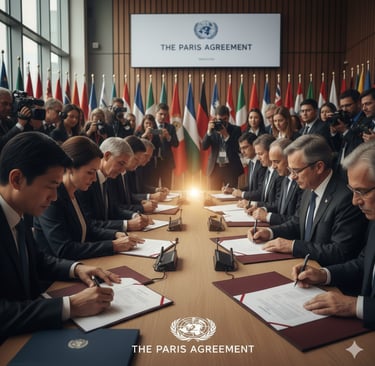The Paris Agreement – The "What, Why, and How"
In the global effort to combat climate change, the *Paris Agreement* stands as a landmark achievement. Adopted in 2015 by nearly every nation, it represents a unified, global commitment to address a shared issue. But unlike its predecessors, the agreement introduced a novel and dynamic framework that is reshaping climate and energy policy worldwide. For professionals and academics in the energy sector, understanding its mechanics is crucial, as it directly influences policy, investment, and technology deployment.
ENERGY INDUSTRYENERGY POLICY
Aadesh Aslekar
9/23/20254 min read


What is the Paris Agreement?
At its core, the Paris Agreement is a legally binding international treaty with the central aim of limiting global temperature rise. Its primary, long-term goal is to hold the increase in the global average temperature to well below 2°C above pre-industrial levels, while pursuing more ambitious efforts to limit the increase to 1.5°C. This target, based on the consensus of the Intergovernmental Panel on Climate Change (IPCC), is designed to avert the most catastrophic impacts of climate change. It also aims to increase the ability to adapt to the adverse impacts of climate change and foster the development of climate resilience and low greenhouse gas emissions, in a manner that does not threaten food production, and to make finance flows consistent with a pathway towards low greenhouse gas emissions and climate-resilient development.
The "Bottom-Up" Approach: Nationally Determined Contributions (NDCs)
The Paris Agreement's most innovative feature is its *"bottom-up" structure, which replaced the top-down, mandated targets of previous climate treaties. Instead, each country submits its own climate action plan, known as a Nationally Determined Contribution (NDC).
This grants each country the autonomy to set its own targets based on its unique national circumstances, economic capabilities, and development priorities. The contributions should be set every five years and are to be registered by the UNFCCC Secretariat. Each further ambition should be more ambitious than the previous one, known as the principle of progression.
NDCs contain steps taken towards emissions reductions and aim to address steps taken to adapt to climate change impacts, and what support the country needs, or will provide, to address climate change.
While the targets themselves are not legally binding, the process of preparing, communicating, and maintaining successive NDCs is. This creates a system of accountability and transparency without the need for enforcement mechanisms that proved difficult in earlier agreements.
As of 31 March 2020, 186 parties (185 countries plus the European Union) had communicated their first NDCs to the United Nations Framework Convention on Climate Change Secretariat.


The "Ratchet Mechanism" and The Global Stocktake
To ensure that collective ambition increases over time, the Paris Agreement created a five-year cycle of progressively more ambitious commitments. This process is informally known as the "ratchet mechanism."
Every five years, countries are required to submit a new or updated NDC that "represents a progression beyond the previous one" and reflects their "highest possible ambition." This cyclical pressure is designed to close the gap between current pledges and the 1.5°C goal.
To inform this cycle, the agreement mandates a Global Stocktake (GST).
The Global Stocktake is designed to raise ambition by helping Parties to:
1. See what they have achieved so far in implementing their NDCs.
2. Identify what still needs to be done to achieve their NDC targets.
3. Identify the approaches that can be taken to enhance their own efforts at national and international level.
The modalities for implementation agreed at the Climate Change Conference in Katowice provide for three stocktake phases:
1. Phase 1: Information collection and preparation:
Phase 1 involves collecting and preparing information needed to conduct the stocktake. Information is taken from various sources. In addition to Parties' nationally determined contributions (NDCs) and the associated reports submitted under the Paris Agreement, the most recent scientific findings of the Intergovernmental Panel on Climate Change (IPCC), as well as inputs from non-governmental stakeholders and observer organisations, are also used. The information gathered is published in the public domain and collated in the form of synthesis reports.
2. Phase 2: Technical assessment of information
In Phase 2, the information is assessed for collective progress in implementing the Paris Agreement and its long-term goals. This sees various stakeholders entering into a series of technical dialogues to discuss the information gathered in Phase 1. Phase 2 is also used to highlight the opportunities to strengthen and enhance response measures in dealing with climate change. The results are documented in a series of reports, including summary reports of each technical dialogue and the final synthesis report.
3. Phase 3: Political messages derived from the technical assessment
In Phase 3, the outcomes of the assessment flow into the policy process. The aim here is to support Parties to the Paris Agreement in enhancing both their climate change policies and the action they take to support other Parties. The outcomes are also used to promote international cooperation.
This is a comprehensive, two-year process that takes place every five years, with the first one concluding at COP28 in 2023.
The GST acts as a global report card, collectively assessing the world's progress toward the Paris Agreement's goals on mitigation, adaptation, and finance. The outcome of the stocktake then serves as a crucial input for countries to use when formulating their next, more ambitious NDCs.
The combination of flexible NDCs, the ratchet mechanism, and the Global Stocktake forms a dynamic, collaborative framework for global climate action. It acknowledges that the path to a decarbonized future will be difficult but provides a clear, repeating process for all nations to follow. In the next part of this series, we will begin our deep dive into the specific commitments and methods of the world's leading economies and largest emitters, starting with North America.
References:
Nationally determined contribution - Wikipedia
https://climateanalytics.org/briefings/15c/
Next Generation NDCs | World Resources Institute
https://www.bbc.com/news/science-environment-35092127
https://unfccc.int/documents/631600
https://indianexpress.com/article/explained/what-is-global-stocktake/
Connect
info@energizetomorrowus.com
© 2025. All rights reserved.


